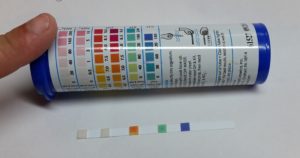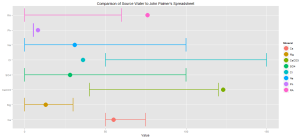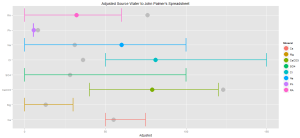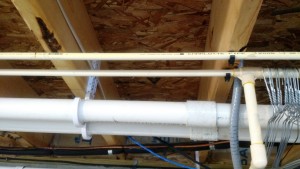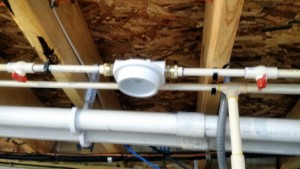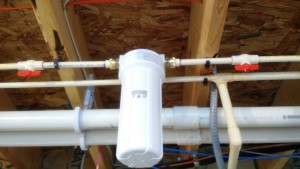Tag Archive: water
Water Part Drei
I brewed last weekend, and somehow my efficiency was way up.
YES HELLO!
I blame this on Bru'n Water – I tried it instead of Palmer's spreadsheet, and it told me to use a fuckton more acid. #homebrew pic.twitter.com/x2HOSn7udq
— Andrew Rohne 🍺🏃🍕 (@HamBrew807) February 4, 2017
According to BeerSmith, my mash efficiency is 87% and my overall brewhouse efficiency is 97%. I don’t believe that second number at all, but the first is pretty damn important to me, and it is wildly better than what I’ve done in the past.
I took one of my last recipes – an IIPA where I got 60% mash efficiency – and took a look in Bru’n Water. Using my water report found on the Internet and what I added based on Palmer’s spreadsheet, my mash pH was likely close to 5.68 after the 4 grams of gypsum and 1 mL of lactic acid. What I should have done was 4 grams of gypsum and 4.5 mL of lactic acid. That would have put my mash pH around 5.34.
Of course this could be a fluke. I did mash in high (the strike water started at 158ºF, I stirred it down to 155ºF), so there could be that. So there will be a part 4 and a part 5. One will be with a past recipe with a revised water adjustment profile, and another will be about my Ward Labs report… once I run a Ward Labs report!
Cheers!
Water Part Deux
So after the low mash efficiency last few beers AND my perception (note 1) of low mash efficiency in my last beer, I started looking at water more.
After looking at my options, I found a page on Braukaiser, and ended up purchasing an aquarium test kit that tests GH, KH, pH, NO2, and NO3. The NO2 and NO3 are unnecessary for brewing, and I had 0 ppm for both of those anyway. Using the spreadsheet and my 180ppm measurements for both GH and KH, I found Ca = 51 ppm and Mg = 13 ppm.
That’s not too different from my old measurements:
Ca: old 54, new 51
Mg: old 13, new 13
The two interesting differences are alkalinity and pH.
Alkalinity: old 123, new 180
pH: Old 8.1, new 7.5.
The total alkalinity is a concern – that’s the ability of the water to buffer changes in acidity. And my pH is lower than expected. So I may not have had the wort in the proper pH range. This could be why I’ve had efficiency problems.
That being typed, I need a good pH meter. That’s really the only point that I came to after all this.
Note 1: I initially thought that I had really poor efficiency, and there is a problem somewhere in my measurements… particularly not taking a pre-boil gravity. I have the first running and the second running and the OG, and I determined a potential amount of sugar in the two runnings and it may be okay. The real problem was that I had far too much strike water and didn’t make any adjustments. I DID figure out that if I use Denny Conn’s method, I can safely assume his assumption that 10 pounds of grain absorbs 1 gallon of strike water, because mine is a hair over that.
On to the next beer!
Down The Rabbit Hole of Water Adjustments
Where I got started on this subject
This all started when I saw a blog post on Practical and Low Cost Water Adjustments. The author there is pretty convincing on the importance of this. Following links from that site, I found this. “Rerun” claims to live “just inside of Clermont County, about a mile east of Beechmont Ford”. I happen to live 5 miles east of Beechmont Ford. Our water in Clermont County comes from three sources and goes into a common distribution system (in other words, they’re all connected).
Coming Brew Day
I eat a lot of Mexican food (well, perhaps “Mexican inspired and styled American food”), and I know that two styles seem to work best: Amber Ale and Vienna Lager. I decided to go with a lager since my fermentation chamber is going to become a keezer. I happen to also see a traditional Vienna Lager on Five Blades Brewing’s website.
Due to availability, I had to substitute Carafa II for the Blackprinz,and carapils for carafoam (there is a lengthy discussion on the difference here). I also added and extra half of a pound of Vienna to compensate for the slightly lower efficiency of my system.
Looking at my source water compared to what John Palmer’s spreadsheet says to use, I’m in range for most of the minerals except for being low on chloride and high on hardness (both calcium carbonate and residual alkalinity).
Water Adjustments
I got John Palmer’s water spreadsheet from the BrewLab kit website. It’s an older version, an updated one is on the How To Brew website. The spreadsheet is fairly easy to use – select a style (from the 2008 styles, not a big deal, really), input my source water info (the boxes are YELLOW), input my RA (I used 0) and my strike water (3.53 gallons). I skipped dilution (left the rate at 0%). The next parts – mineral additions, acid, and results all work together – I looked at where I wasn’t in the range – which was only chloride, and added a gram of a mineral that provides chloride. That mineral is canning salt (NaCl, sodium chloride), so after adding a gram I noticed I was near the middle of the chloride range without exceeding the sodium range (up to 100 ppm). I also saw that total alkalinity was too high (by a measly 3 ppm), but that kept the residual alkalinity up high (76 compared to 0-60) which appears to cause the beer to be darker than expected (and this is expected, as I think all my beers have been darker than I planned). I added a milliliter of 88% lactic acid which reduced the total alkalinity to the middle of the range and the color to 7 – 14 SRM (the target is 10-16, the beer as planned is 10.4 SRM).
Finally, I went down to step 8, which is sparge water treatment. I’m sparging with 6 gallons, so I input the recommended 4 ml of lactic acid for my sparge water.
In the end, 1 gram of canning salt (pure sodium chloride) and 1 ml of lactic acid to the strike water, and 4 ml of lactic acid to the sparge water.
I’m typing this on Saturday night and I brew on Sunday. We’ll see how this works out.
Cheers!
Removing that $%@! Chlorine
I live in an area with great water for pale beers, and great water in general… except for the chlorine.
My previous way to prepare beer was to use a 1/2″ hose from my refrigerator dispenser to a fermenting bucket. Then, I had to carry the buckets to the basement brewery to use. Last time, I did this the night before, which was good from the standpoint that the filter in the fridge is crap and had my wife’s ultra-sensitive palate complaining of the chlorine flavor. Sitting overnight allows the chlorine to leave the water.
Not one to want to carry heavy buckets of water around (especially since I’ve recently been diagnosed with a major back injury) and wanting to brew again, I decided to fix that problem once and for all. Enter the whole-house water filter.
After running water through the plumbing for several minutes and bleeding the air out of a few other faucets, I handed my wife a glass of tap water and asked her to drink. She looks at me, smiles, and says “nothing”.
Cheers!
